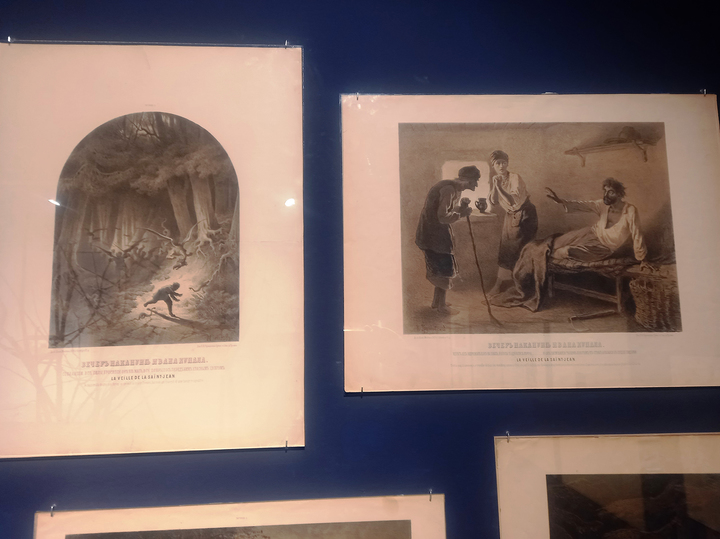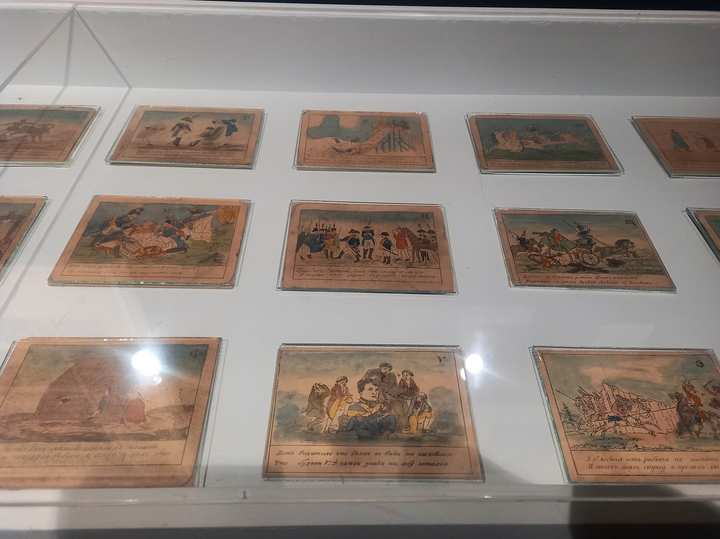They invented the “horror” genre, began to “hunt” dinosaurs: what is the era of romanticism remembered for?
[ad_1]
On February 16, a “panoramic” exhibition about romanticism in Russian literature opened at the Ilya Ostroukhov House. The organizers of the project dedicated four halls of the ancient mansion in Trubniki to the main genres, filling the museum space with priceless objects that belonged to great writers, lifetime editions of classics and chilling quotes and illustrations. A MK correspondent visited the GMIRL department not far from Novy Arbat. The literary museum’s project “From Elegy to Horror: the Age of Romanticism in Russia” turned out to be not purely literary – and all thanks to interaction with other metropolitan museums, including the Paleontological Museum.
The “Alpha” or symbolic “highlight” of the exhibition should be recognized as a cast of the theriodont skull – in the caption to the fossilized remains of the ancient predator it is stated that it was during the times of romanticism (the end of the 18th – the first half of the 19th centuries, in the Russian Empire the peak occurred in the 1810-1830s ) the “hunt for dinosaurs” began. Only then were they first looked at as witnesses to the historical past of the Earth, and not as the bones of biblical giants.

In fact, this is not reflected in the literature. There was a whole century left before Conan Doyle’s “The Lost World” and Obruchev’s “Plutonia” – but as an illustration of the revolutionary nature of romanticism, the skull works perfectly.
The romantics “finished off” those ideals that the creators of the Renaissance could not overcome; they picked up certain tendencies of sentimentalism (love of ruins and cemeteries
– Zhukovsky’s “Rural Cemetery” is a perfect example of this, where
Under the roof of black pines and leaning elms,
Which stand around, hanging,
Here are the forefathers of the village, in secluded graves
Shutting themselves up forever, they sleep soundly.).
They also continued the “return to nature” and rebellion against the existing world order

Attractive for Zhukovsky, Pushkin or Baratynsky, ruins, abandoned ancient houses, wild forests or “natural” rural landscapes as a place for walks and poetic contemplation are presented in the exhibition in illustrations and paintings of the century before last. This particular walk is embodied in the authentic cane of Ivan Turgenev, a writer who emerged from romanticism rather than remained in it, but this subtlety does not reduce the value of the exhibit.

The second of the halls is dedicated to the historical story as a key genre – there is a lot of Napoleon and his main winner – “one emperor for all” Alexander I. Among the valuable items – a complete version of the so-called “Terebenevskaya alphabet” (“As a gift to children in memory of 1812” ) – a set of cartoon cards about the defeat and expulsion of the French from Russia. Here is also a rare booklet from 1812, “Napoleon in Captivity on the Island of St. Helena,” a lifetime edition of Stepan Vasilyevich Russov’s Ode to Alexander “in case of Napoleon’s overthrow.”

I will not dwell in detail on the filling of the hall dedicated to the elegy: but I was completely amazed by the paintings exhibited there by the poet Konstantin Batyushkov with a “fable” theme: “Birds on the Branches,” “Buffalo and the Rainbow,” “Birds and Grapes.” Everyone knows that Mikhail Lermontov, or, say, Taras Shevchenko were also artists, as well as the fact that Alexander Sergeevich had the habit of decorating his manuscripts with drawings and cartoons. But Batyushkov the artist will be a real discovery for someone.

But we are moving towards the most interesting part.
The third room of the project is darkened, its walls are covered with black velvet, also hanging in “flakes” from the chandelier. They scare us for a reason – in European romanticism Hoffman did this, in Russian – Gogol, Pushkin, Pogorelsky. Yes, they are the founders of Russian horror.
Fear and horror reign in the St. Petersburg story “Portrait” by Nikolai Vasilyevich: there appears a picture in which is the soul of a moneylender who ruined and killed many people (the illustrations for the work are truly terrible).

Pushkin’s most terrible story, “The Undertaker” about the dead people who came to visit the main character, was not remembered at the exhibition, but they showed Vladimir Titov’s book “The Secluded House on Vasilievsky”, created according to Pushkin’s plot, where evil spirits interfere with the earthly affairs of people.
“It seemed to her that a cold hand was stroking her face… she jumped up. A lamp was burning in front of the image, and nothing unusual was visible in the room; but her heart was trembling with fear: she clearly heard that someone was walking around the room and sighing heavily… Then it was as if the door opened and creaked… and someone came down the stairs” – this is a quote from the collection “The Double, or My Evenings in Little Russia” (the story “Lafertovskaya Poppy”) by Anthony Pogorelsky, and it was painted in white letters on the black surface of a strange mirror.
Surprisingly, for both Antony Alekseevich and Gogol (here we enter the final hall, it is bright – but with black crows on the walls) the Little Russian lands were a mystical and mysterious place.

Lithographs for “The Evening on the Eve of Ivan Kupala” with a blooming fern glowing in the darkness, with dark entities inhabiting the night forest, made our ancestors feel horror. This is not Ershov’s fairy tale: the firebird, a living island, a talking horse – magic – yes, but with an age gradation of “0+”.
But you need to understand that Stephen King’s horror films or “A Nightmare on Elm Street” did not arise in a vacuum; they are firmly based on the Gothic novel, romantic story and poem, and trace their ancestry to folklore and myth.
Answering the question of why at some point a person needed to scare himself is not the task of this article.
But it is impossible not to mention that not only dinosaurs were once raised from the dust into the Light of God. The fact that folk tales, beliefs, traditions and rituals, the living Russian folk language itself is a priceless treasure, was the first to truly realize in our country by the figures of romanticism. The State Literary Museum is named after Vladimir Dahl, the Luhansk son of a Russified Dane, who devoted his entire life to collecting words, which the exhibition also tells about. The basis for this Russian giant of biblical proportions was again the “revolutionary” romantic era.
[ad_2]
Source link






